Spatial Distribution of Shrubs Impacts Relationships among Saltation, Roughness, and Vegetation Structure in an East Asian Rangeland
Abstract
1. Introduction
2. Materials and Methods
2.1. Study Area
2.2. Field Survey
2.3. Estimating the Spatial Arrangement of Shrubs with a Semivariogram
2.4. Estimation of Saltation Flux
2.5. Calculations of z0 and d0
- u1 > 8
- u1 > u2 > u3
- −1 < θj+1 < −θj < 0.5
2.6. Calculation of
2.7. Analysis
3. Results
3.1. Comparisons among Groups Classified by Hierarchical Clustering
3.2. Wind Conditions and Dust Events
3.3. Ground Surface Conditions
3.4. Linear Regression Analysis
4. Discussion
Author Contributions
Funding
Acknowledgments
Conflicts of Interest
References
- Abulaiti, A.; Kimura, R.; Shinoda, M.; Kurosaki, Y.; Mikami, M.; Ishizuka, M.; Yamada, Y.; Nishihara, E.; Gantsetseg, B. An observational study of saltation and dust emission in a hotspot of Mongolia. Aeolian Res. 2014, 15, 169–176. [Google Scholar] [CrossRef]
- Kurosaki, Y.; Shinoda, M.; Mikami, M.; Nandintsetseg, B. Effects of Soil and Land Surface Conditions in Summer on Dust Outbreaks in the Following Spring in a Mongolian Grassland. Sola 2011, 7, 69–72. [Google Scholar] [CrossRef]
- Mayaud, J.R.; Webb, N.P. Vegetation in drylands: Effects on wind flow and aeolian sediment transport. Land 2017, 6, 64. [Google Scholar] [CrossRef]
- Shao, Y.; Dong, C.H. A review on East Asian dust storm climate, modelling and monitoring. Glob. Planet. Chang. 2006, 52, 1–22. [Google Scholar] [CrossRef]
- Carmichael, G.R.; Sakurai, T.; Streets, D.; Hozumi, Y.; Ueda, H.; Park, S.U.; Fung, C.; Han, Z.; Kajino, M.; Engardt, M.; et al. MICS-Asia II: The model intercomparison study for Asia Phase II methodology and overview of findings. Atmos. Environ. 2008, 42, 3468–3490. [Google Scholar] [CrossRef]
- UNEP. World Atlas of Desertification, 2nd ed.; Middleton, N., Thomas, D., Eds.; Edward Arnold: London, UK, 1997. [Google Scholar]
- Kurosaki, Y.; Shinoda, M.; Mikami, M. What caused a recent increase in dust outbreaks over East Asia? Geophys. Res. Lett. 2011, 38. [Google Scholar] [CrossRef]
- Shao, Y.; Raupach, M.R.; Findlater, P.A. Effect of saltation bombardment on the entrainment of dust by wind. J. Geophys. Res. 1993, 98, 12719–12726. [Google Scholar] [CrossRef]
- Shao, Y. Simplification of a dust emission scheme and comparison with data. J. Geophys. Res. D Atmos. 2004, 109, D10202. [Google Scholar] [CrossRef]
- Wolfe, S.A.; Nickling, W.G. The protective role of sparse vegetation in wind erosion. Prog. Phys. Geogr. 1993, 17, 50–68. [Google Scholar] [CrossRef]
- Betz, F.; Halik, Ü.; Kuba, M.; Tayierjiang, A.; Cyffka, B. Controls on aeolian sediment dynamics by natural riparian vegetation in the Eastern Tarim Basin, NW China. Aeolian Res. 2015, 18, 23–34. [Google Scholar] [CrossRef]
- Yoshikawa, K. New restoration engineering in Northeast Asia. Glob. Environ. Res. 2010, 14, 37–46. [Google Scholar]
- Kimura, R.; Shinoda, M. Spatial distribution of threshold wind speeds for dust outbreaks in northeast Asia. Geomorphology 2010, 114, 319–325. [Google Scholar] [CrossRef]
- Munson, S.M.; Belnap, J.; Okin, G.S. Responses of wind erosion to climate-induced vegetation changes on the Colorado Plateau. Proc. Natl. Acad. Sci. USA 2011, 108, 3854–3859. [Google Scholar] [CrossRef]
- Sasaki, T.; Koyama, A.; Okuro, T. Coupling structural and functional thresholds for vegetation changes on a Mongolian shrubland. Ecol. Indic. 2018, 93, 1264–1275. [Google Scholar] [CrossRef]
- Raupach, M.R.; Gillette, D.A.; Leys, J.F. The effect of roughness elements on wind erosion threshold. J. Geophys. Res. 1993, 98, 3023–3029. [Google Scholar] [CrossRef]
- Marticorena, B.; Bergametti, G. Modeling the atmospheric dust cycle: 1. Design of a soil-derived dust emission scheme. J. Geophys. Res. 1995, 100, 16415–16430. [Google Scholar] [CrossRef]
- Foroutan, H.; Young, J.; Napelenok, S.; Ran, L.; Appel, K.W.; Gilliam, R.C.; Pleim, J.E. Development and evaluation of a physics-based windblown dust emission scheme implemented in the CMAQ modeling system. J. Adv. Model. Earth Syst. 2017, 9, 585–608. [Google Scholar] [CrossRef]
- Shao, Y.; Yang, Y. A theory for drag partition over rough surfaces. J. Geophys. Res. Earth Surf. 2008, 113. [Google Scholar] [CrossRef]
- Davidson-Arnott, R.G.D.; Bauer, B.O.; Walker, I.J.; Hesp, P.A.; Ollerhead, J.; Chapman, C. High-frequency sediment transport responses on a vegetated foredune. Earth Surf. Process. Landf. 2012, 37, 1227–1241. [Google Scholar] [CrossRef]
- Okin, G.S.; Gillette, D.A. Distribution of vegetation in wind-dominated landscapes: Implications for wind erosion modeling and landscape processes. J. Geophys. Res. Atmos. 2001, 106, 9673–9683. [Google Scholar] [CrossRef]
- Okin, G.S. A new model of wind erosion in the presence of vegetation. J. Geophys. Res. Earth Surf. 2008, 113. [Google Scholar] [CrossRef]
- Dupont, S.; Bergametti, G.; Simoëns, S. Modeling aeolian erosion in presence of vegetation. J. Geophys. Res. Earth Surf. 2014, 119, 168–187. [Google Scholar] [CrossRef]
- Mayaud, J.R.; Bailey, R.M.; Wiggs, G.F.S. A coupled vegetation/sediment transport model for dryland environments. J. Geophys. Res. Earth Surf. 2017, 122, 875–900. [Google Scholar] [CrossRef]
- Webb, N.P.; McCord, S.E.; Edwards, B.L.; Herrick, J.E.; Kachergis, E.; Okin, G.S.; Van Zee, J.W. Vegetation Canopy Gap Size and Height: Critical Indicators for Wind Erosion Monitoring and Management. Rangel. Ecol. Manag. 2021, 76, 78–83. [Google Scholar] [CrossRef]
- Wasson, R.J.; Nanninga, P.M. Estimating wind transport of sand on vegetated surfaces. Earth Surf. Process. Landf. 1986, 11, 505–514. [Google Scholar] [CrossRef]
- Ash, J.E.; Wasson, R.J. Vegetation and sand mobility in the Australian desert dunefield. Z. Geomorphol. Suppl. 1983, 45, 7–25. [Google Scholar]
- Okin, G.S.; Sala, O.E.; Vivoni, E.R.; Zhang, J.; Bhattachan, A. The interactive role of wind and water in functioning of drylands: What does the future hold? Bioscience 2018, 68, 670–677. [Google Scholar] [CrossRef]
- Okin, G.S.; De Las Heras, M.M.; Saco, P.M.; Throop, H.L.; Vivoni, E.R.; Parsons, A.J.; Wainwright, J.; Peters, D.P.C. Connectivity in dryland landscapes: Shifting concepts of spatial interactions. Front. Ecol. Environ. 2015, 13, 20–27. [Google Scholar] [CrossRef]
- Li, J.; Okin, G.S.; Herrick, J.E.; Belnap, J.; Miller, M.E.; Vest, K.; Draut, A.E. Evaluation of a new model of aeolian transport in the presence of vegetation. J. Geophys. Res. Earth Surf. 2013, 118, 288–306. [Google Scholar] [CrossRef]
- Kurosaki, Y.; Mikami, M. Threshold wind speed for dust emission in east Asia and its seasonal variations. J. Geophys. Res. Atmos. 2007, 112. [Google Scholar] [CrossRef]
- Undarmaa, J.; Okuro, T.; Nyamtseren, Z.; Yamanaka, N. Rangeland Plants of Mongolia, 2nd ed.; Undarmaa, J., Yamanaka, N., Eds.; Munkhiin Useg: Ulaanbaatar, Mongolia, 2020; Volume 2, pp. 70, 92. ISBN 978-99978-740-8-5. [Google Scholar]
- Matsushima, D.; Kimura, R.; Kurosaki, Y.; Ganzorig, U.; Shinoda, M. A Method for Estimating the Threshold Wind Speed for Dust Emissions as a Function of Soil Moisture. Bound. Layer Meteorol. 2020, 175, 237–257. [Google Scholar] [CrossRef]
- Kong, K.; Nandintsetseg, B.; Shinoda, M.; Ishizuka, M.; Kurosaki, Y.; Bat-Oyun, T.; Gantsetseg, B. Seasonal variations in threshold wind speed for saltation depending on soil temperature and vegetation: A case study in the Gobi Desert. Aeolian Res. 2021, 52, 100716. [Google Scholar] [CrossRef]
- Nandintsetseg, B.; Shinoda, M. Land surface memory effects on dust emission in a Mongolian temperate grassland. J. Geophys. Res. Biogeosci. 2015, 120, 414–427. [Google Scholar] [CrossRef]
- Bradski, G. The OpenCV Library. Dr. Dobb’s J. Softw. Tools Prof. Program. 2000, 25, 120–123. [Google Scholar]
- Udo, K.; Kuriyama, Y.; Jackson, D.W.T. Observations of wind-blown sand under various meteorological conditions at a beach. J. Geophys. Res. Earth Surf. 2008, 113. [Google Scholar] [CrossRef]
- Abulaiti, A.; Kimura, R.; Shinoda, M. Vegetation effects on saltation flux in a grassland of Mongolia. Sand Dune Res. 2013, 59, 117–127. [Google Scholar]
- Mikami, M.; Toya, T.; Yasuda, N. An analytical method for the determination of the roughness parameters over complex regions. Bound. Layer Meteorol. 1996, 79, 23–33. [Google Scholar] [CrossRef]
- Mikami, M. Bulk Parameterization of Fluxes and Energy Budget over Various Land Surfaces. Geophys. Mag. Ser. 2 1997, 2, 9–76. [Google Scholar]
- Ishizuka, M.; Mikami, M.; Yamada, Y.; Zeng, F. Threshold Friction Velocities of Saltation Sand Particles for Different Soil Moisture Conditions in the Taklimakan Desert. Sola 2009, 5, 184–187. [Google Scholar] [CrossRef]
- Ishizuka, M.; Mikami, M.; Yamada, Y.; Kimura, R.; Kurosaki, Y.; Jugder, D.; Gantsetseg, B.; Cheng, Y.; Shinoda, M. Does Ground Surface Soil Aggregation Affect Transition of the Wind Speed Threshold for Saltation and Dust Emission? Sola 2012, 8, 129–132. [Google Scholar] [CrossRef]
- Owen, P.R. Saltation of uniform grains in air. J. Fluid Mech. 1964, 20, 225–242. [Google Scholar] [CrossRef]
- Benjamini, Y.; Hochberg, Y. Controlling the False Discovery Rate: A Practical and Powerful Approach to Multiple Testing. J. R. Stat. Soc. Ser. B 1995, 57, 289–300. [Google Scholar] [CrossRef]
- Okin, G.S.; Gillette, D.A.; Herrick, J.E. Multi-scale controls on and consequences of aeolian processes in landscape change in arid and semi-arid environments. J. Arid Environ. 2006, 65, 253–275. [Google Scholar] [CrossRef]
- Daniels, G.E. Terrestrial Envirionment (climatic) Criteria Guidelines for Use in Aerospace Vehicle Develepment, 1973 Revision. In NASA Technical Memorandum; National Aeronautics and Space Administration: Washington, DC, USA, 1973. [Google Scholar]
- King, J.; Nickling, W.G.; Gillies, J.A. Aeolian shear stress ratio measurements within mesquite-dominated landscapes of the Chihuahuan Desert, New Mexico, USA. Geomorphology 2006, 82, 229–244. [Google Scholar] [CrossRef]
- Shao, Y. Physics and Modelling of Wind Erosion; Springer: Dordrecht, The Netherlands, 2008. [Google Scholar]
- Skamarock, W.C.; Klemp, J.B.; Dudhia, J.B.; Gill, D.O.; Liu, Z.; Berner, J.; Wang, W.; Powers, J.G.; Duda, M.G.; Barker, D.M.; et al. A Description of the Advanced Research WRF Model Version 4.3; National Center for Atmospheric Research: Boulder, CO, USA, 2021.
- Gantsetseg, B.; Ishizuka, M.; Kurosaki, Y.; Mikami, M. Topographical and hydrological effects on meso-scale vegetation in desert steppe, Mongolia. J. Arid Land 2017, 9, 132–142. [Google Scholar] [CrossRef][Green Version]
- Gillette, D.A.; Stockton, P.H. The effect of nonerodible particles on wind erosion of erodible surfaces. J. Geophys. Res. 1989, 94, 12885–12893. [Google Scholar] [CrossRef]
- Liu, J.; Kimura, R.; Miyawaki, M.; Kinugasa, T. Effects of plants with different shapes and coverage on the blown-sand flux and roughness length examined by wind tunnel experiments. Catena 2021, 197, 104976. [Google Scholar] [CrossRef]
- Phillips, D.L.; Macmahon, J.A. Competition and Spacing Patterns in Desert Shrubs. J. Ecol. 1981, 69, 97–115. [Google Scholar] [CrossRef]
- Skarpe, C. Spatial patterns and dynamics of woody vegetation in an arid savanna. J. Veg. Sci. 1991, 2, 565–572. [Google Scholar] [CrossRef]
- Zheng, J.; He, M.; Li, X.; Chen, Y.; Li, X.; Liu, L. Effects of Salsola passerina shrub patches on the microscale heterogeneity of soil in a montane grassland, China. J. Arid Environ. 2008, 72, 150–161. [Google Scholar] [CrossRef]
- Xu, J.; Gu, H.; Meng, Q.; Cheng, J.; Liu, Y.; Jiang, P.; Sheng, J.; Deng, J.; Bai, X. Spatial pattern analysis of Haloxylon ammodendron using UAV imagery—A case study in the Gurbantunggut Desert. Int. J. Appl. Earth Obs. Geoinf. 2019, 83, 101891. [Google Scholar] [CrossRef]
- Cruzan, M.B.; Weinstein, B.G.; Grasty, M.R.; Kohrn, B.F.; Hendrickson, E.C.; Arredondo, T.M.; Thompson, P.G. Small Unmanned Aerial Vehicles (Micro-Uavs, Drones) in Plant Ecology. Appl. Plant Sci. 2016, 4, 1600041. [Google Scholar] [CrossRef] [PubMed]
- Garcia-Moya, E.; McKell, C.M. Contrubution of Shrubs to the Nitrogen Economy of a Desert-Wash Plant Community. Ecology 1970, 51, 81–88. [Google Scholar] [CrossRef]
- Schlesinger, W.H.; Reynolds, J.F.; Cunningham, G.L.; Huenneke, L.F.; Jarrell, W.M.; Virginia, R.A.; Whitford, W.G. Biological Feedbacks in Global Desertification. Science 1990, 247, 1043–1048. [Google Scholar] [CrossRef]
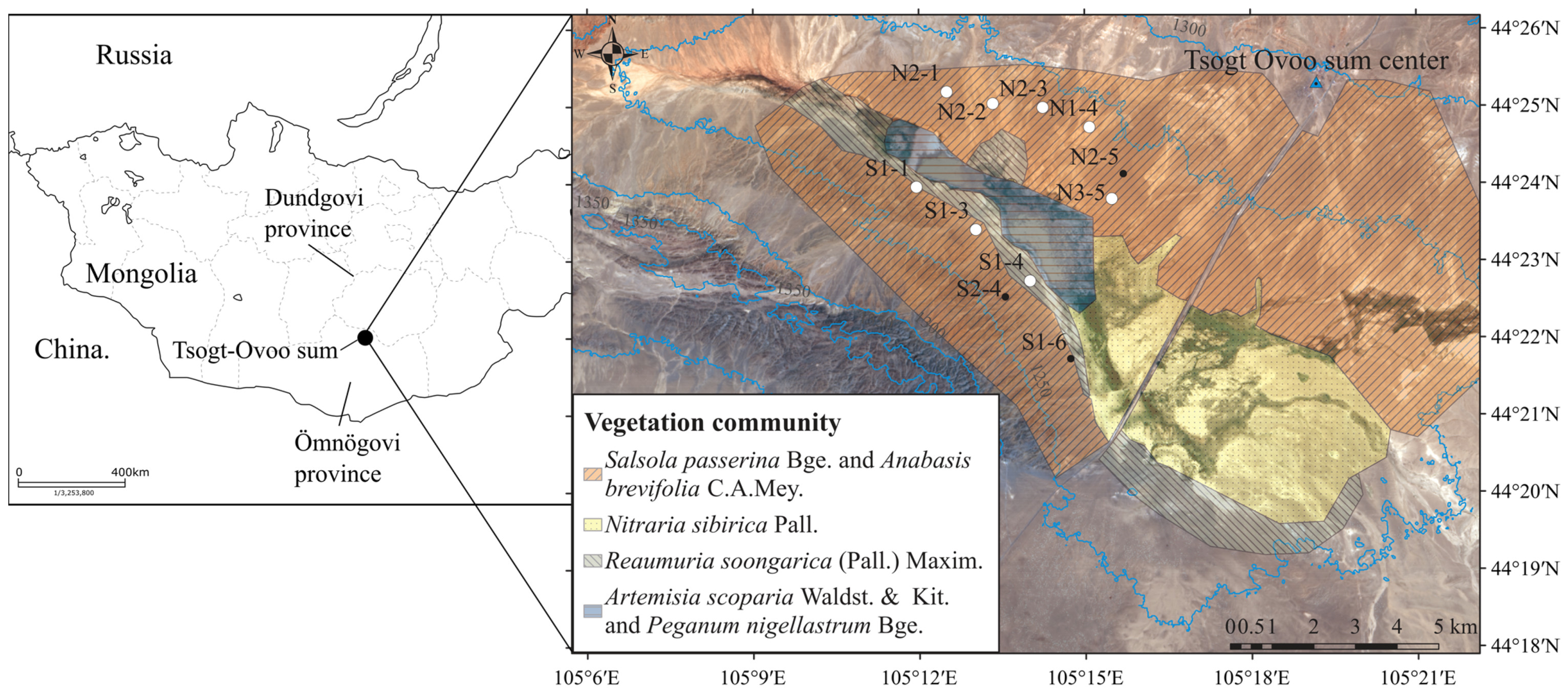
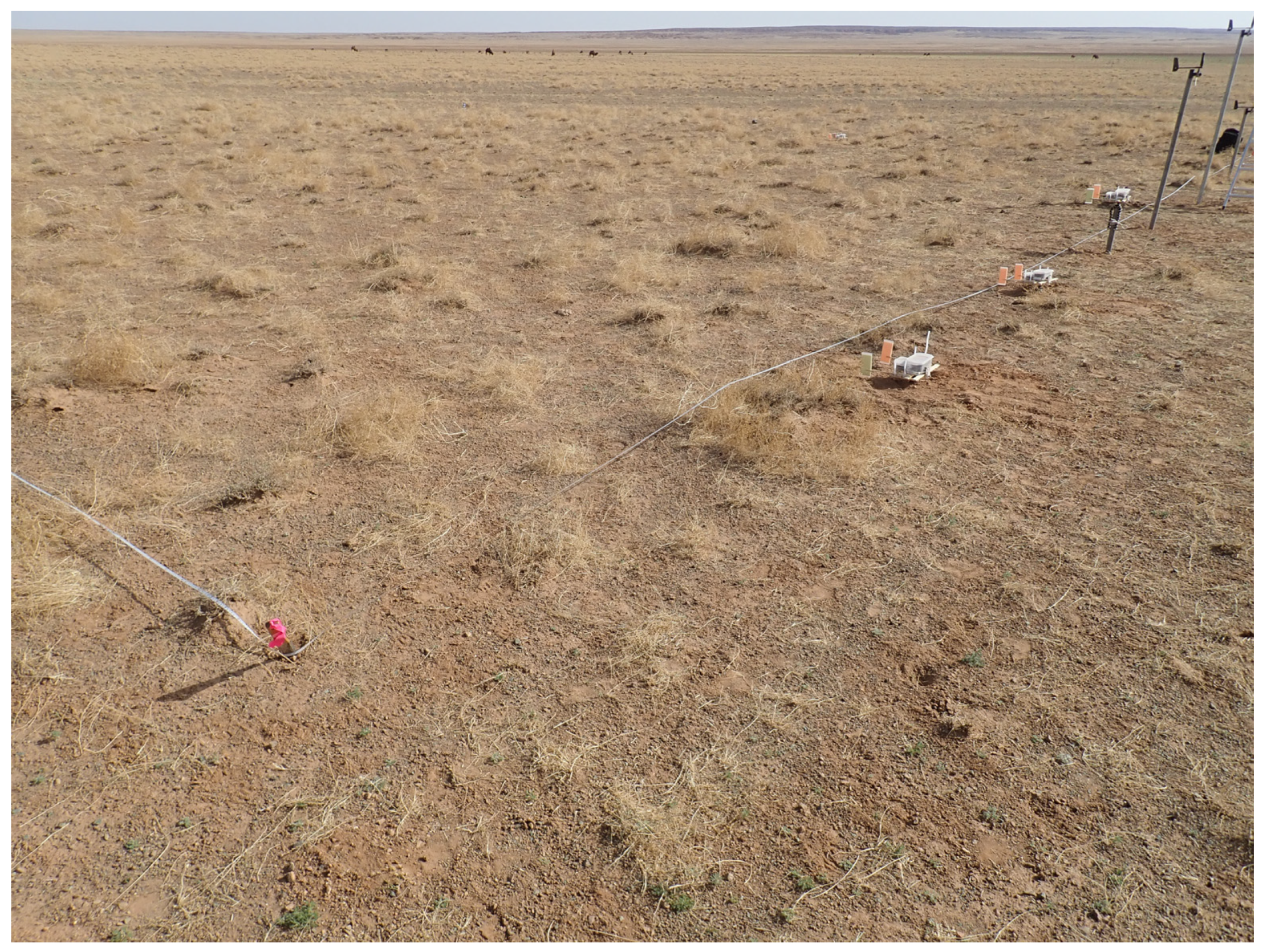
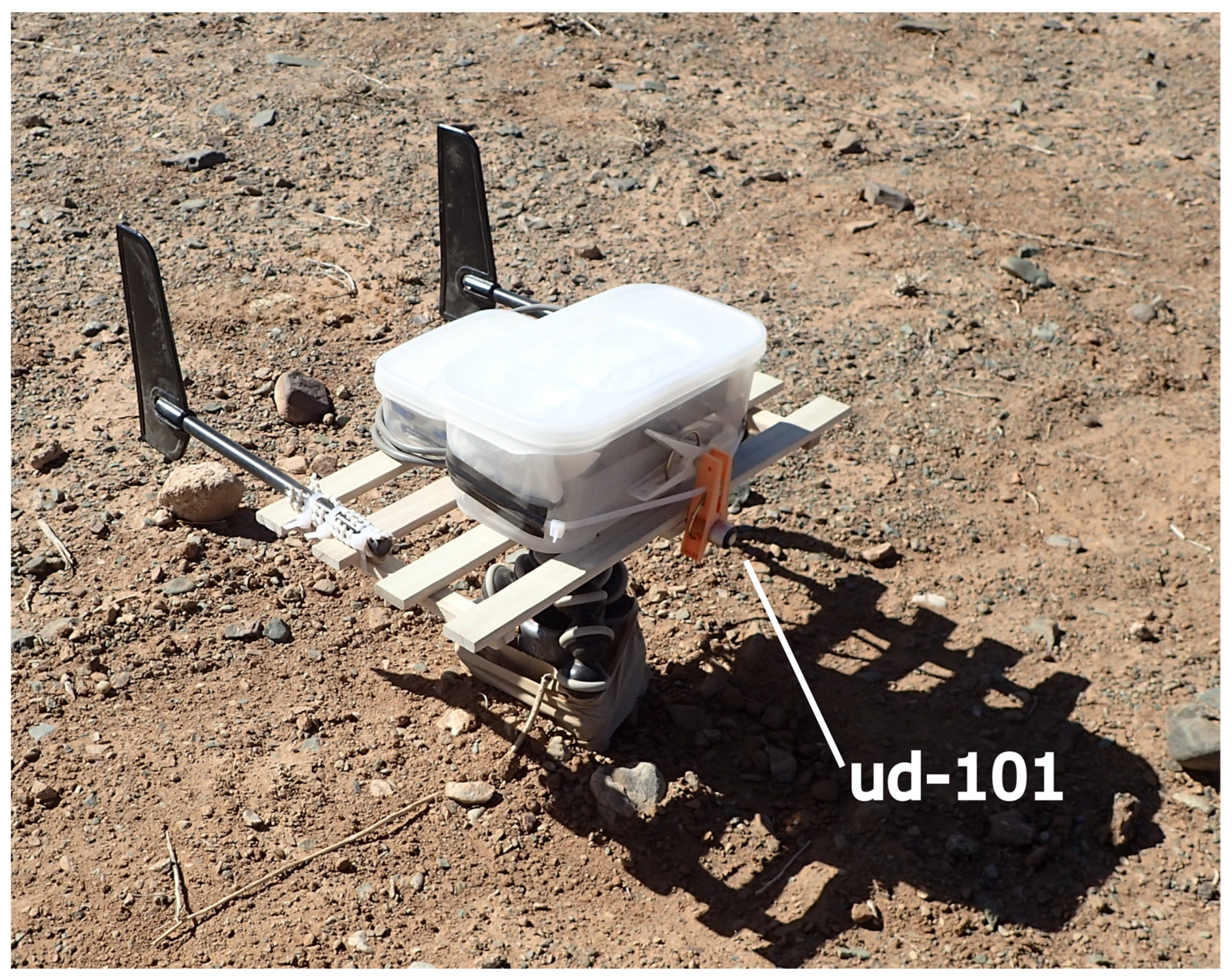
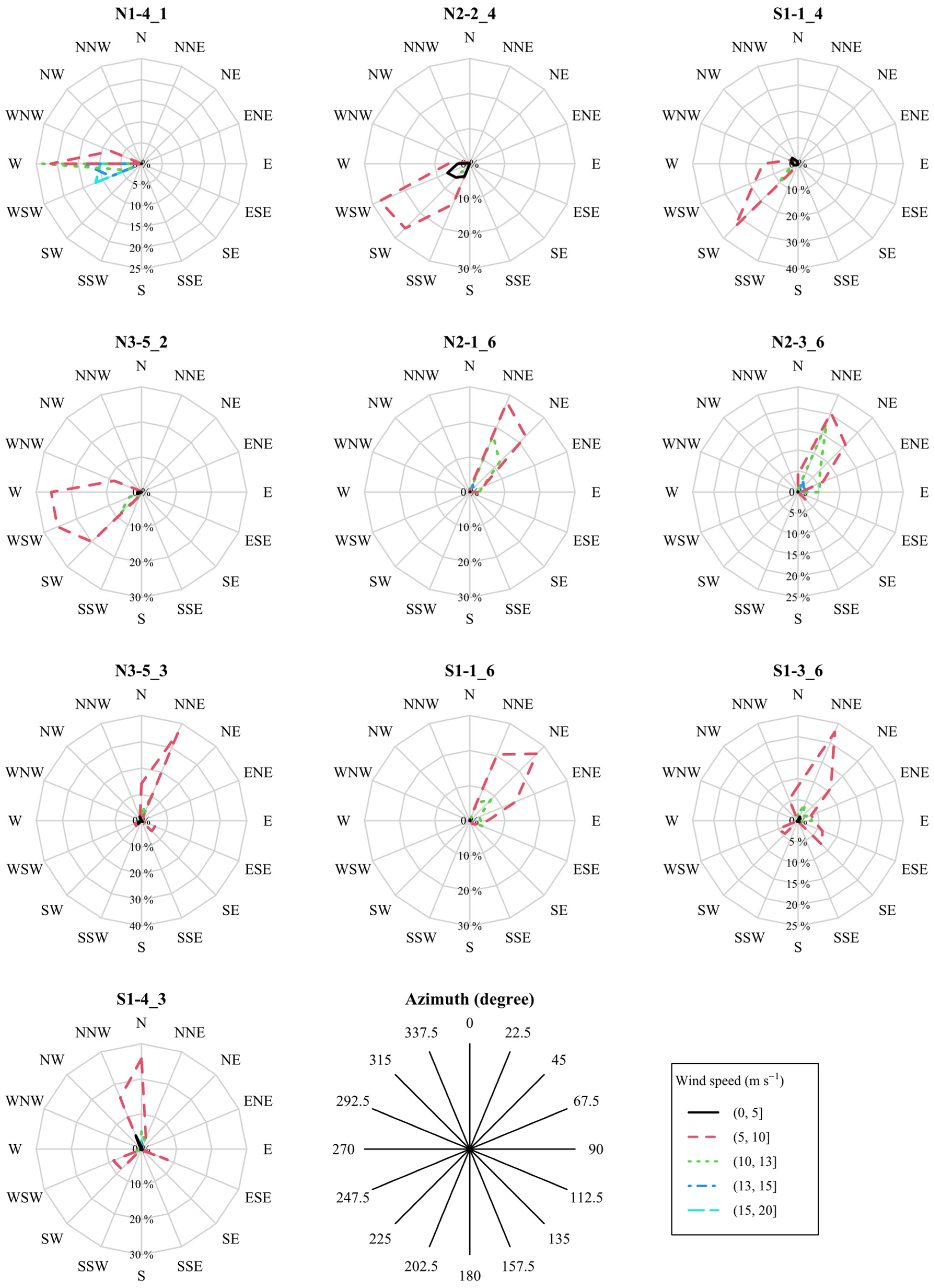
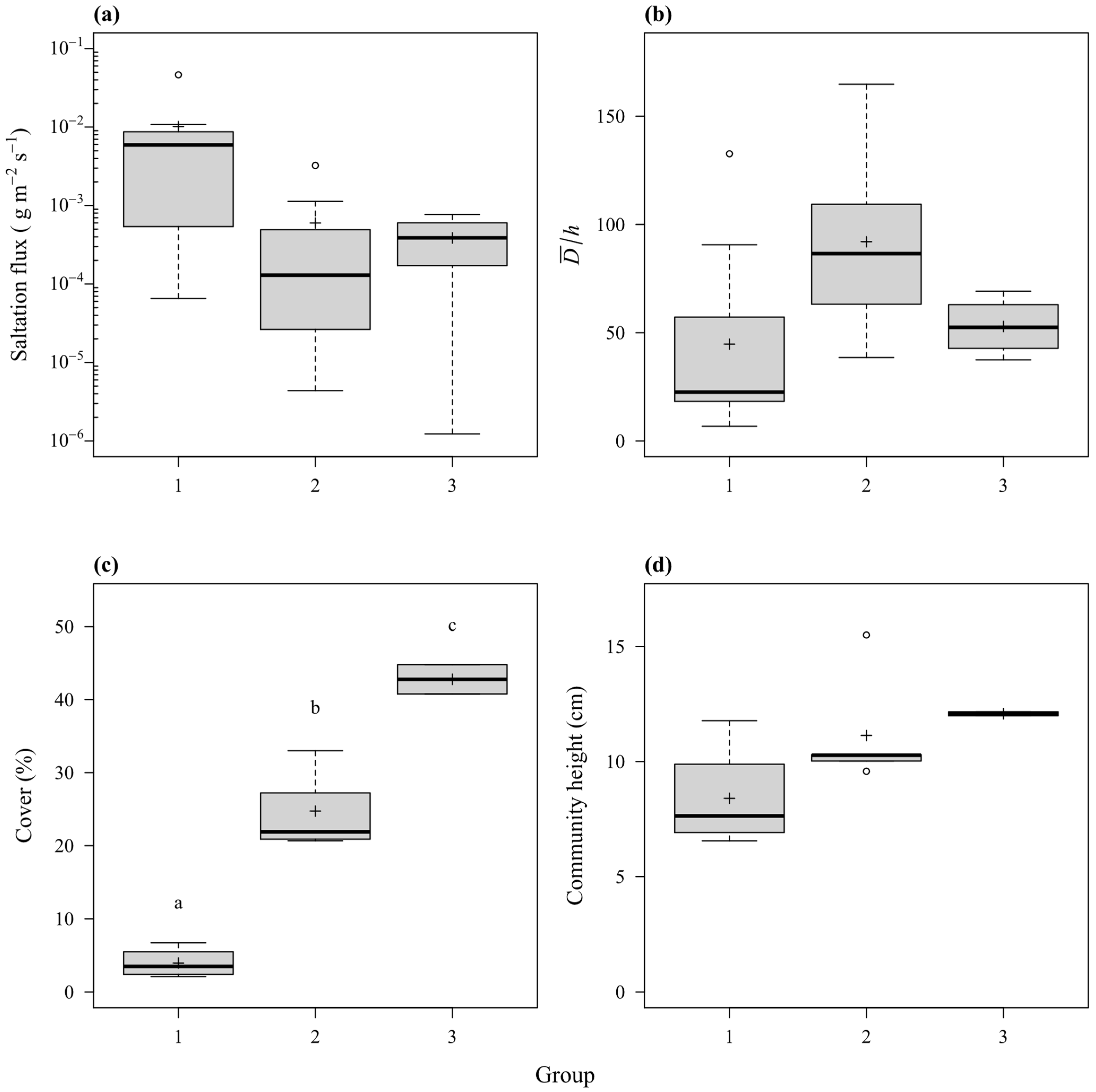
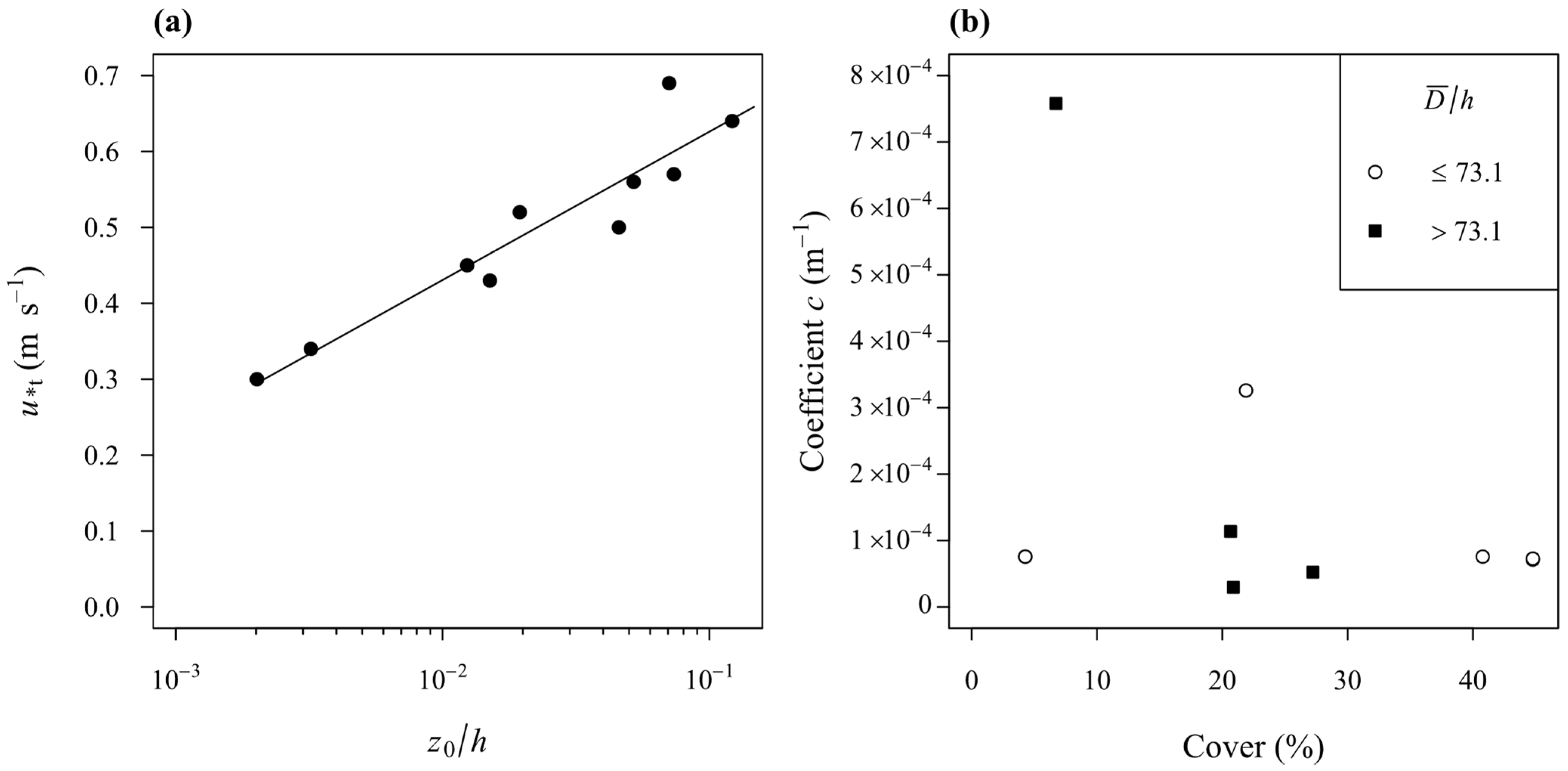

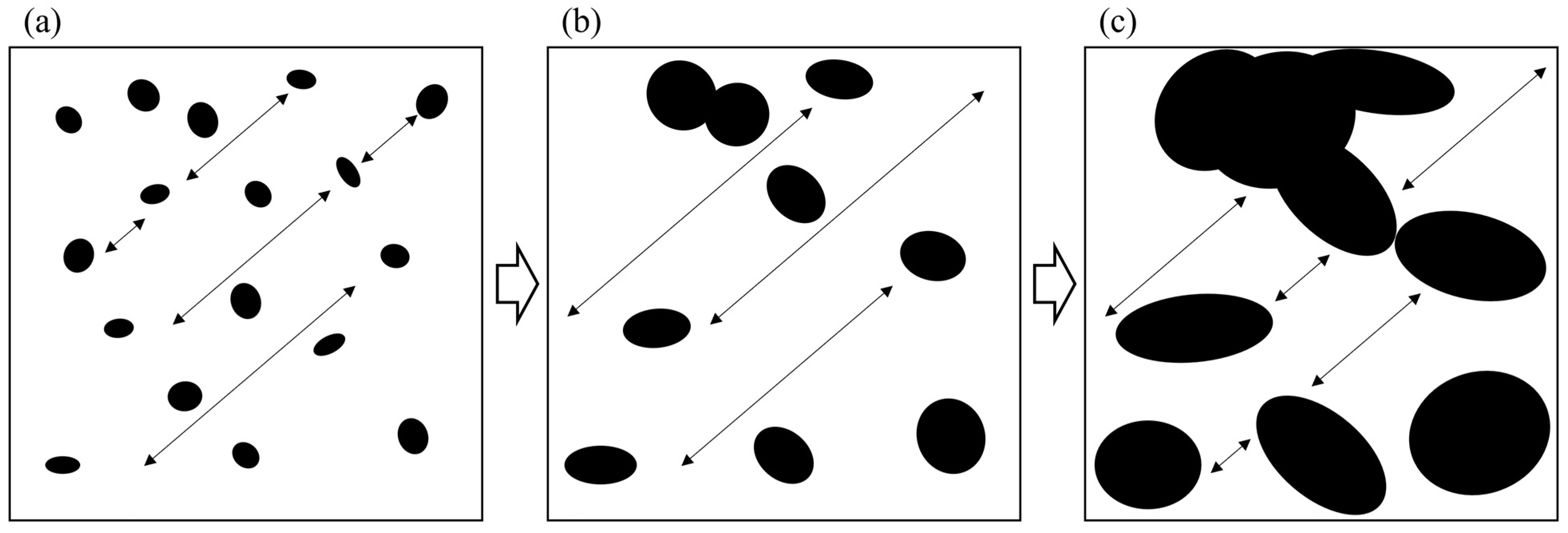
| Site ID | Event | Cluster Group | Soil Surface Conditions | Vegetation | |||||
|---|---|---|---|---|---|---|---|---|---|
| Gravel Size | Gravel Amount | Crust | Cracks | Cover (%) (S.E.) | Com. Height (cm) (S.E.) | ||||
| S1-1 | 4 * | 1 | medium | large | weak | small | 4.3 (1.5) | 11.8 (2.7) | 22.6 |
| 5 | 1 | medium | large | weak | small | 4.3 (1.5) | 11.8 (2.7) | 6.8 | |
| 6 * | 1 | medium | large | weak | small | 4.3 (1.5) | 11.8 (2.7) | 23.8 | |
| S1-4 | 2 | 1 | medium | large | weak | small | 6.7 (2.6) | 8.0 (1.9) | 132.7 |
| 3 * | 1 | medium | large | weak | small | 6.7 (2.6) | 8.0 (1.9) | 90.6 | |
| S1-6 | 1 | 1 | small | large | weak | small | 2.7 (0.7) | 6.6 (1.2) | 18.4 |
| S2-4 | 1 | 1 | medium | large | weak | small | 2.1 (0.5) | 7.3 (1.6) | 18.2 |
| N1-4 | 1 * | 2 | small | middle | weak | small | 21.9 (2.7) | 10.3 (1.3) | 72.5 |
| N2-1 | 5 | 2 | medium | large | weak | small | 20.7 (2.5) | 10.3 (0.9) | 93.1 |
| 6 * | 2 | medium | large | weak | small | 20.7 (2.5) | 10.3 (0.9) | 151.8 | |
| N2-2 | 4 * | 2 | small | large | weak | small | 27.2 (4.4) | 10.0 (1.5) | 109.3 |
| N2-5 | 2 | 2 | small | large | weak | small | 33.0 (4.8) | 9.6 (0.5) | 164.7 |
| 3 | 2 | small | large | weak | small | 33.0 (4.8) | 9.6 (0.5) | 48.4 | |
| S1-3 | 4 | 2 | small | large | weak | small | 20.9 (3.1) | 15.5 (1.1) | 38.5 |
| 5 | 2 | small | large | weak | small | 20.9 (3.1) | 15.5 (1.1) | 63.2 | |
| 6 * | 2 | small | large | weak | small | 20.9 (3.1) | 15.5 (1.1) | 86.5 | |
| N2-3 | 5 | 3 | small | large | weak | small | 40.8 (4.5) | 12.0 (1.0) | 37.5 |
| 6 * | 3 | small | large | weak | small | 40.8 (4.5) | 12.0 (1.0) | 56.8 | |
| N3-5 | 2 * | 3 | small | large | weak | small | 44.8 (5.5) | 12.2 (0.7) | 48.1 |
| 3 * | 3 | small | large | weak | small | 44.8 (5.5) | 12.2 (0.7) | 69.2 | |
| Response Variable | Explanatory Variable | Estimate (S.E.) | t Value | p Value | ||
|---|---|---|---|---|---|---|
| (a) | Intercept | 0.82 (0.04) | 19.04 | <0.001 | ** | |
| 0.08 (0.01) | 7.88 | <0.001 | *** | |||
| Adjusted R-squared: | 0.87 | <0.001 | *** | |||
| (b) | Intercept | 1.98 × 10−4 (4.82 × 10−5) | 4.11 | 0.006 | ** | |
| Cover | −1.67 × 10−5 (4.63 × 10−6) | −3.61 | 0.011 | * | ||
| −2.16 × 10−6 (1.65 × 10−6) | −1.31 | 0.237 | ||||
| −5.48 × 10−7 (1.69 × 10−7) | −3.24 | 0.018 | * | |||
| Adjusted R-squared: | 0.56 | 0.049 | * | |||
| (c) | Intercept | 4.79 × 10−2 (7.62 × 10−3) | 6.29 | <0.001 | *** | |
| Cover | −2.98 × 10−3 (7.32 × 10−4) | −4.07 | 0.007 | ** | ||
| −6.03 × 10−4 (2.60 × 10−4) | −2.32 | 0.059 | † | |||
| −1.04 × 10−4 (2.67 × 10−5) | −3.90 | 0.008 | ** | |||
| Adjusted R-squared: | 0.63 | 0.029 | * |
Publisher’s Note: MDPI stays neutral with regard to jurisdictional claims in published maps and institutional affiliations. |
© 2021 by the authors. Licensee MDPI, Basel, Switzerland. This article is an open access article distributed under the terms and conditions of the Creative Commons Attribution (CC BY) license (https://creativecommons.org/licenses/by/4.0/).
Share and Cite
Kono, A.; Okuro, T. Spatial Distribution of Shrubs Impacts Relationships among Saltation, Roughness, and Vegetation Structure in an East Asian Rangeland. Land 2021, 10, 1224. https://doi.org/10.3390/land10111224
Kono A, Okuro T. Spatial Distribution of Shrubs Impacts Relationships among Saltation, Roughness, and Vegetation Structure in an East Asian Rangeland. Land. 2021; 10(11):1224. https://doi.org/10.3390/land10111224
Chicago/Turabian StyleKono, Akito, and Toshiya Okuro. 2021. "Spatial Distribution of Shrubs Impacts Relationships among Saltation, Roughness, and Vegetation Structure in an East Asian Rangeland" Land 10, no. 11: 1224. https://doi.org/10.3390/land10111224
APA StyleKono, A., & Okuro, T. (2021). Spatial Distribution of Shrubs Impacts Relationships among Saltation, Roughness, and Vegetation Structure in an East Asian Rangeland. Land, 10(11), 1224. https://doi.org/10.3390/land10111224






